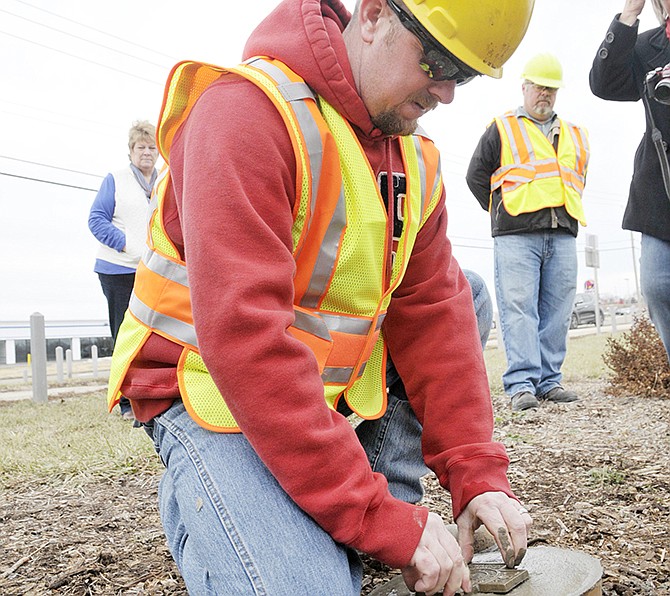A chance discovery in a box from an estate sale ultimately led to Thursday's placing of a new marker at the foot of a statue in Jefferson City.
The statue commemorates Missouri's efforts in the 1898 Spanish-American and Philippine-American wars and the U.S. involvement in the Boxer Rebellion.
At the end of a brief ceremony Thursday morning, a state Transportation department crew placed the marker - a brass cross - into some fresh concrete poured into the ground below the statue, which commands the center position in the Blue Star Memorial Highway roadside park between the U.S. 50 Expressway and Missouri Boulevard, west of the Stadium Boulevard intersection.
Earlier this year, Charles Chamberlin of Jefferson City began the process of getting the cross to be part of the memorial, after he "found it in an estate sale, in a (box of) $50 worth of brass and stuff. ... My assumption is that, somewhere along the line, they were going to melt it down - and I found that to be highly inappropriate."
The brass medallion he found in that box "has some designations, or some comments on it, about the Spanish-American War," Chamberlin said, "so I looked it up on the Internet.
"And it came up as a grave marker for a society of Spanish-American, Boxer Rebellion (and) Philippine War veterans."
The wars are interrelated.
The Spanish-American War lasted about five months, from April-August 1898. When Spain ceded victory to the United States, the Philippines in the Western Pacific became a U.S. territory - and the next U.S. headache, since the Filipino natives already had started their own fight for independence from Spain, and transferred that fight to the U.S. with a war that ran from 1898-1902.
And, from 1899-1901, some Chinese (known as "Boxers") tried to push foreigners out of their land and remove Christian influences in their country. Western forces, including soldiers from the U.S., eventually invaded China and conquered the Imperial Army.
The monument in the roadside park is a memorial to more than 10,000 Missourians who served in those conflicts.
Sue Chamberlin joined in her husband's enthusiasm for the cross, after his initial Internet search showed what it was.
And, Sue said, their experience should serve as advice for others who might buy a box of stuff and not look through it thoroughly.
"I think that's important. It's our history," she said.
The Missouri Boulevard roadside park was placed there when what now is Missouri Boulevard was U.S. 50 - and the site was in the country, west of Jefferson City's limits.
Many who drive past the site today may not pay much attention to the little park between busy roads, and the statue that was added in 1967.
"I think that's sad," Sue Chamberlin said, "because thousands of men gave their lives - not just for Missouri.
"I think people should look and see what's around them, more."
Charles Chamberlin is one of the people who sometimes pulls into the park to eat lunch.
"So, I knew our veteran (statue) was here," he said, "and it seemed like a highly appropriate place for this (cross) to end up."
He sent an e-mail to the Federated Garden Clubs' state president, seeking help with finding the marker a new "home' in the roadside park. A series of contacts followed, ultimately reaching Marge Talken, president of Jefferson City's Bittersweet Garden Club - one of the groups that helps keep the roadside park clean.
"When somebody presents you with an item like this, and asks you, "Can Bittersweet help to get it placed?'" Talken explained, "I take that seriously and I thought, "I'm going to do whatever research I can to see if we can find a home for it.
"That's what we did, and I'm so happy with the way it turned out."
After meeting with Charles Chamberlin and taking control of the marker, Talken eventually contacted MoDOT.
Rand Swanigan, MoDOT's Central District roadside manager, was excited with the idea of putting the marker in the park.
"My concern was being able to mount it in a way that it would not be taken - so that other people could see it," he said.
He noted the monument itself is "something that's been here for many years (and is) a very important part of our history, and something we like to have prominent, so people can learn."
Talken also uses the park occasionally as a place to eat "when I didn't want to eat and drive," but had paid little attention to the statue and its purpose.
She said seeing the marker has increased her interest.
"The older you get, I think the more important those sorts of things are to you," she said. "You think more about history and preserving it."
Both Chamberlins agreed that - even though the Spanish-American and Philippine-American wars were fought more than a century ago - people should remember those who fought in them, and why.
"If we don't remember history, we're going to repeat it," Sue Chamberlin said.
If nothing else, Charles added, the marker should be a reminder to all to "remember our veterans."


